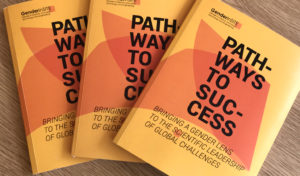Complex global challenges can only be addressed through meaningful international collaboration and ‘integrated science’ which brings together scientists from different disciplines to co-construct knowledge. Yet the institutions which underpin these international collaborations are by and large still dominated by elite white men. There are few women in scientific leadership and agenda-setting roles, let alone women of colour and women from the global south; and data shows a broader worldwide gender imbalance in social and natural science, and technology and innovation.
Not only are women missing out on socioeconomic opportunities for professional and personal growth, but their perspectives are frequently absent or marginalised in the ‘spaces’ where scientific agendas and policies are shaped, and research frequently overlooks or ignores women’s perspectives, experiences and contributions. Yet gender equity in science, technology and innovation is vital for the achievement of the SDGs and key for building and sustaining peace. Applying a gender lens to science, technology and innovation can provide deeper insights, more effective programmes and more sustainable development outcomes.
Bringing a Gender Lens to the Scientific Leadership of Global Challenges
A new GenderInSITE report, Pathways to Success: Bringing a Gender Lens to the Scientific Leadership of Global Challenges, co-authored by IDS staff, was discussed at a roundtable at the 63rd Session of the Commission on the Status of Women in New York. Roseanne Diab, Director of GenderInSITE – an international initiative to promote the role of women in science, innovation, technology and engineering (SITE) – showcased the report as a contribution to global debates on gender, science and technology.

The report shows how policies promoting gender equity and science have evolved and developed at different levels in the scientific system: from the day-to-day work of individual scientists and the halls of their research institutes, on up through to multi-lateral organisations like the science policy bodies of the United Nations and the European Union.
Understanding women’s pathways to success
Interviews with leading female scientists sought to understand how some women have made it through to senior leadership positions in global science, despite there being no clear signposting for them to navigate their way. The report highlights their alternative pathways to success, and how, in their success, they have championed institutional change which can be so elusive and hard to achieve.
The interviews showed how women’s commitment to addressing societal challenges in their work propelled them to their positions of leadership. As one woman put it; “When you grow up on a continent where people are starving and you know your science can do something to help, then that’s part of why you do it… Bringing change and sustainable livelihoods to people is very important for me, because at the end of the day, I am still the girl from that village.” Interviewees also stressed the importance of mentoring and role modelling and of reshaping organisational cultures by introducing family-friendly policies.
Getting gender equality on the agenda
At other levels of the scientific system the report shows how a multiplicity of tactics and strategies are needed to get gender equality onto the agenda. For example, in the European Union, a combination of building the evidence base of empirical data and the use of technical language alongside strategic and concerted efforts by feminist activists has led to significant policy achievements. This success is embodied in Horizon 2020, the EU’s largest research and innovation programme ever, funded to the tune of 80bn Euros. Just one of the programme’s gender-forward features is that gender balance in research teams is now a ranking factor in the proposal evaluation process for major Horizon 2020 grants. Ensuring that gender remains addressed both in the research and in the research teams remains however an ongoing challenge which requires continued concerted efforts.
Connecting up to address unequal power relations
Our research also shows however, that it is not enough to address the challenges of individual women scientists, to amend organisational policies, or to ensure that research on today’s global challenges includes a gender component. Rather, efforts must be made to connect these steps to create multiple, reinforcing pathways to success. New pathways towards gender equality in global scientific endeavours and leadership need to address unequal power relations on a number of social and political dimensions at multiple scales: from the personal to the global. The report makes a series of recommendations, including that gender-related evidence more explicitly informs international science itself, that international science organisations consistently advocate for gender equality in science, and that they support this with additional resources.